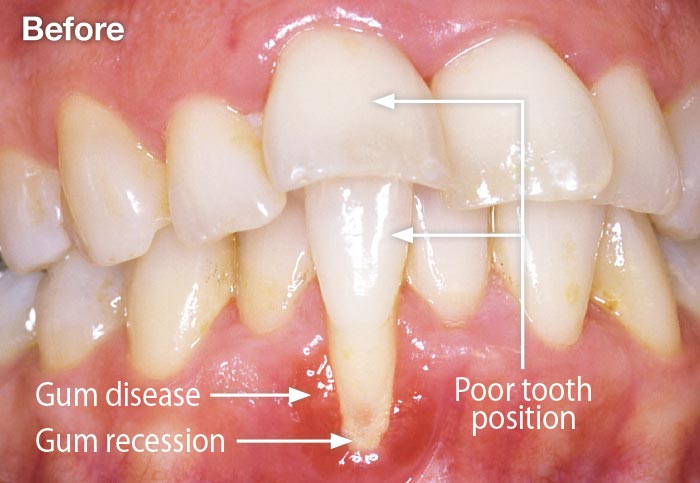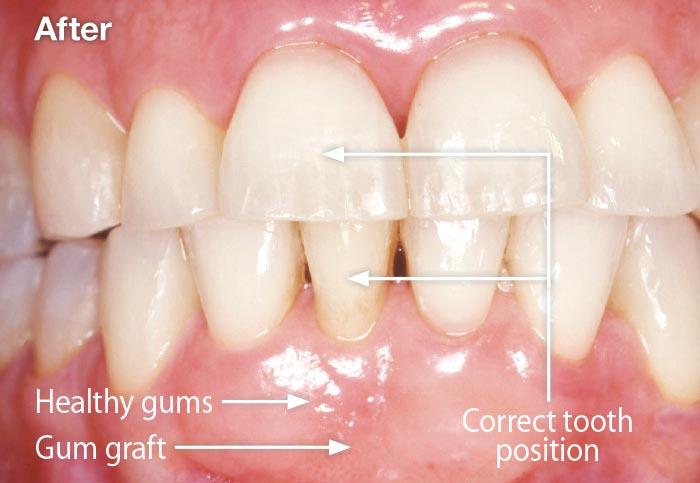Gum Recession
Why you get "long in the tooth" — and what your dentist can do about it
(Continued)
Non-Surgical Treatments
If periodontal disease is found, it may be controlled with a treatment called scaling and root planing. This is a thorough professional cleaning that goes below the gum line to not only remove sticky plaque and hardened calculus, but also to smooth the root surfaces, promoting reattachment of the gums and elimination of inflammation. Education about the most effective methods for maintaining good oral hygiene is also an important part of non-surgical treatment. That's because, if the mouth is not kept healthy and disease free, treatment can be compromised and recession can continue.
When recession is minimal and confined to a small area, a restorative material like tooth-colored composite can be used to correct cosmetic defects and relieve discomfort. Composite is a dental material composed of a plastic and glass mixture that is applied to the exposed root surface. It is then hardened with a special light which bonds the material to the tooth. In certain cases, dental composites can reduce sensitivity and improve the tooth's appearance.
Sometimes, multiple parts of the mouth have recession, with exposed roots and black triangle gaps. In this situation, if surgery is not a viable option, a gingival mask — a type of artificial gum — may be considered. This prosthetic (artificial) device stays in place in part by using moisture from the mouth, similar to the way a contact lens stays connected to the eye. It is fabricated after taking impressions of your teeth and gums, and custom-fitted to go over them, concealing unappealing gaps in the smile.
Gum Grafts: Rejuvenating Tissue
If gum tissue damage is caused by periodontal disease, or if there isn't enough tissue remaining, your dentist may recommend periodontal plastic surgery (gum grafting). Gum grafting is typically performed by a periodontist, a dentist who specializes in treating supporting tissues of the teeth. There are many kinds of gum grafts where new tissue is added onto the area of recession, and they often produce excellent results.
 |
| Figure 3: Exposed tooth root surface caused from a combination of poor tooth position and gum disease. |
 |
| Figure 4: Using a combination of necessary treatments including orthodontics to correct the poor tooth position and periodontal plastic surgery using a gum graft, the exposed root surface is covered by new gum tissue. |
When recession occurs in less visible areas of the mouth, a graft may be done to restore and thicken gum tissue. In this procedure, a very thin layer of tissue is taken from the roof of the mouth (palate). A space or "pocket" is created in the area affected by recession, and the donor tissue is inserted into it. The grafted tissue is secured using ultra fine stitches, and in time becomes firmly attached in its new location (figure 4).
Exposed tooth roots can be covered with a different procedure called a subepithelial connective tissue graft. In this procedure, a thin piece of tissue is removed from the inside of the palate. The tissue is then grafted in the area of recession, covering the exposed roots. The grafted tissue is in turn covered with adjacent tissue providing the necessary blood supply for the graft to be successful. Soon, the body's natural recovery process takes over: New blood vessels begin growing into the graft, and it eventually becomes integrated with the surrounding tissue.
In some situations, existing gum tissue near the site of recession may be used in a procedure called a pedicle graft. Here, the tissue is loosened and then rotated to cover the exposed root surface. Another option is to use laboratory processed tissue (human or animal) which is safe for use in surgery. When covered over with mature gum tissue adjacent to the site of recession, processed tissue can yield excellent results. A successful gum grafting procedure can reduce risk of further recession and help you enjoy a healthier and better-looking smile.
Maintaining Healthy Gums
After treatment is complete and gums are healthy, your job truly starts. Maintaining healthy gums means following your dentist's instructions for proper at-home care. This will include brushing and flossing regularly and getting professional cleanings every three to six months, depending on your needs. Talk to your dentist about the health of your gums and he or she will be happy to advise you. Getting regular dental visits, maintaining proper hygiene, and avoiding bad habits like smoking will increase the chances that that your gums remain healthy for a very long time.



